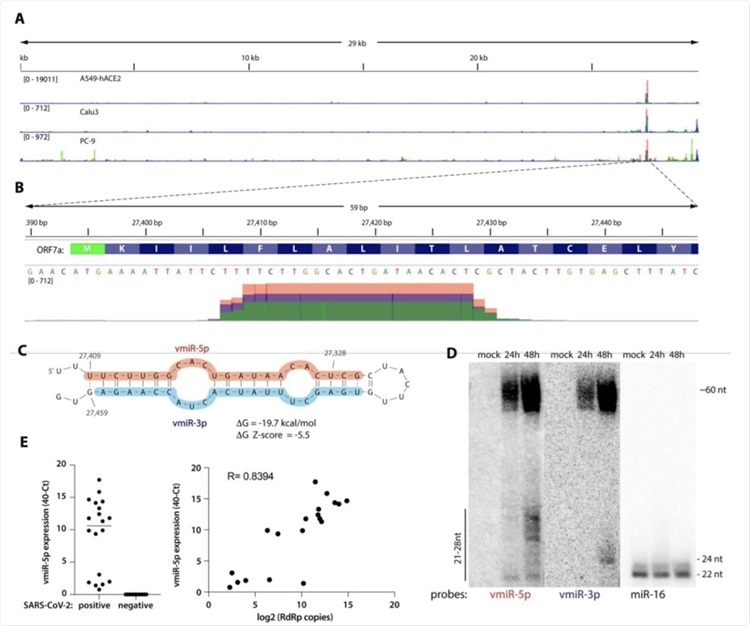Medical Alert! SARS-CoV-2 Expresses miRNA: vmiR-5p That Reduces Host Transcription And Suppresses Host Genes, Increasing Its Pathogenicity!
Source: Medical Alerts Sep 14, 2021 3 years, 6 months, 2 weeks, 2 days, 23 hours, 40 minutes ago
Medical Alert: Yet another alarming study finding on the multitude of negative effects that the novel coronavirus has on the human host, this time from a research by scientist from Yale University School of Medicine, Icahn School of Medicine at Mount Sinai, and Iowa State University.
The research findings reveals that the SARS-CoV-2 coronavirus expresses a microRNA or miRNA called vmiR-5p that is able to reduce and disrupt human host transcription, thus suppressing selected host genes which aids I the virus pathogenicity.

The study team investigated the impact of SARS-CoV-2 infection on host microRNA (miRNA) populations in three human lung-derived cell lines, as well as in nasopharyngeal swabs from SARS-CoV-2 infected individuals.
The team did not detect any major and consistent differences in host miRNA levels after SARS-CoV-2 infection.
Shockingly instead, the study team unexpectedly discovered a viral miRNA-like small RNA, named vmiR-5p (for viral miRNA), derived from the SARS-CoV-2 ORF7a transcript. Its abundance ranges from low to moderate as compared to host miRNAs.
This vmiR-5p miRNA functionally associates with Argonaute proteins which are core components of the RNA interference pathway that lead to downregulation of host transcripts.
It was found that one such host messenger RNA that was suppressed, encodes Basic Leucine Zipper ATF-Like Transcription Factor 2 (BATF2), which is linked to interferon signaling.
The study findings demonstrate that vmiR-5p production relies on cellular machinery, yet is independent of Drosha protein, and is enhanced by the presence of a strong and evolutionarily conserved hairpin formed within the ORF7a sequence.
This newly discovered viral miRNA called vmiR-5p may contribute to SARS-CoV-2 pathogenesis.
The study findings were published on a preprint server and are currently being peer reviewed.
https://www.biorxiv.org/content/10.1101/2021.09.08.459464v1
The SARS-CoV-2 coronavirus that triggered the ongoing COVID-19) pandemic that brought life to a grinding halt in much of the inhabited world for most of 2020 and 2021 is still fast accelerating with major surges expected in coming weeks.
As these surges continue to cause thousands of new infections and deaths worldwide each day, researchers are earnestly seeking to understand how SARS-CoV-2 works to infect host cells and inactivate host defenses.
This
Medical Alert warns about the new study that finds the viral non-coding ribonucleic acid (RNA) dubbed vmiR-5p, derived from the viral gene open reading frame 7a (ORF7a) appears to reduce host transcription, which could contribute to the pathogenicity of SARS-CoV-2. This new finding could provide a new therapeutic target against SARS-CoV-2.
The SARS-CoV-2 coronavirus is a large RNA virus that causes both human and animal infection. Although SARS-CoV-2 generally is associated with its respiratory manifestations, in severe and critical cases, it induces overwhelming inflammation that results in multi-organ dysfunction and even deat
h.
The present study involves microRNAs (miRNAs), which are about 22 nucleotides in length. These miRNAs comprise non-coding RNA molecules (ncRNAs) that modulate gene expression in the post-transcriptional stage. This action is mediated by partial inhibition or mRNA decay.
Although messenger RNA (mRNA) is typically being synthesized in the cytoplasm, the enzyme RNA polymerase II causes primary miRNA molecules to be transcribed, all of which have a characteristic tendency to form strong hairpins. The endonuclease Drosha recognizes such hairpin sequences and cleaves them, leading to the production of miRNA precursors that are about 70 nucleotides in length.
Subsequently these precursor molecules are trafficked into the cytoplasm where they are cleaved by another enzyme known as Dicer, which assists in the formation of duplex miRNAs that are 22 nucleotides in length. These become the cargo of host Argonaute (Ago) proteins.
It should be noted that at this point, the passenger strand is removed. The Ago proteins bind to target sequences that are partly complementary to the miRNA. These sequences are mostly in the 3′ untranslated region (UTR) of mRNAs. This binding causes inhibition of translation of these mRNAs or their decay.
Importantly when the target mRNA and binding miRNA sequences are almost completely complementary, the Ago2 protein cleaves the mRNA. This cleavage is an action that is more characteristic of small interfering RNA molecules (siRNAs).
Again, it should be noted that both these functions are part of the RNA interference (RNAi) pathway.
The Ago2-mediated RNA cleavage however occurs at a lower copy number and silences the target gene more powerfully than the standard miRNA mode of action.
Interestingly the number and types of miRNAs differ by the host cell and stage of development. Also, each miRNA is capable of reducing the level of expression of a range of transcripts. The outcome is a precise tuning of gene expression of almost all mRNAs as required by each type of cell at its particular stage.
Importantly the presence of abnormal miRNAs is typically a marker of disease. Very often, this is the case with a viral infection, as viruses take over this mechanism to reduce the level of host miRNAs or produce their own miRNAs.

A) Viral small RNA reads obtained from the three cell lines infected with SARS-CoV-2 map to a single distinct peak within the viral genome (data for MOI 5, 24 hpi are shown). The replicates for each cell line were overlayed on a single track (represented by different colors) and are normalized to 107 total reads. MOI-multiplicity of infection. B) The reads coming from SARS-CoV-2 (∼20 nt-long) map near the beginning of the ORF7a gene (encoded amino acids are shown above the nucleotide sequence). Data from Calu-3 cells are shown. C) vmiR-5p forms a hairpin with the sequence immediately downstream in the viral genome. Shaded nucleotides indicate the sequences detected by Northern blot probes: pink for 5p and blue for 3p. D) vmiR-5p can be detected by Northern blotting of extracts from Calu-3 cells infected with SARS-CoV-2 at MOI 0.05. E) As measured by custom TaqMan RT-qPCR, vmiR-5p is present in nasopharyngeal samples from SARS-CoV-2-infected individuals (right panel), with its levels correlating with viral load (left panel). RdRp ie RNA-dependent RNA polymerase
For instance, herpes viruses transcribes certain sequences that lead to the selective decay of some host miRNAs through a process known as target-directed miRNA degradation (TDMD).
Another example is the poxvirus poly(A) polymerase that causes extensive miRNA polyadenylation that ultimately leads to miRNA decay.
Also viruses can use unconventional non-RNAi pathways to avoid the need for Drosha, rather than synthesizing their own miRNAs in the cytoplasm.
It should be noted that coronaviruses such as SARS-CoV-2 may be of this kind, producing small viral RNAs (svRNAs) as part of their disease-producing activity, including miRNA-like strands that trigger inflammation and type I interferon (IFN) signaling.
This study findings reports the discovery of a viral miRNA called vmiR-5p, which is a miRNA-like viral ncRNA that is expressed by SARS-CoV-2.
Although SARS-CoV-2 does not appear to affect the host miRNAs to an appreciable extent, as shown by the tiny number of small RNA sequences obtained from infected host cells, a potentially valuable observation is that after SARS-CoV-2 infection, the miRNA abundance was increased, whereas two other small ncRNA classes were reduced.
This implies that the virally-induced shut-off of host transcripts does not affect host miRNA production, perhaps because the latter are protected within circulating exosomes.
This findings also points to the potential for using small RNAs to treat COVID-19.
Interestingly among the viral miRNAs, about 5% were 20-nucleotide sequences related to the ORF7a, which is a viral gene that encodes one of the viral accessory proteins and is implicated in innate immunity. The protein is thought to be an antagonist of the type I IFN response.
It has been found that deletions of ORF7a are associated with decreased innate immune evasion. However, these deletions chiefly affect the C-terminal end of the protein, while leaving the N-terminal end, which contains vmiR-5p, intact.
Significantly, this ncRNA is part of a strong hairpin that is highly conserved in coronaviruses. The presence of this hairpin identifies it as a miRNA since hairpin formation occurs during the biogenesis of miRNAs.
Also this vmiR-5p sequence is found in SARS-CoV-2 infection and is positively related to the viral load/genomic RNA.
The study team found that vmiR-5p binds to Ago proteins and may silence host target transcripts. Thus, even though vmiR-5p is expressed at low levels, its association with Ago proteins exploits sequence complementarity that can cause significant target mRNA cleavage while tolerating a small number of mismatched nucleotides.
The study team could not quantitatively assay the effect of vmiR-5p on mRNA transcription within infected cells due to the large-scale suppression of host transcription.
However utilizing synthetic vmiR-5p, the study team found that two predicted target host mRNAs were downregulated.
Interestingly one of these downregulated mRNAs is the Basic Leucine 18 Zipper ATF-Like Transcription Factor 2 (BATF2), which is involved in IFN-gamma signaling. The other mRNA was Heparan Sulfate Proteoglycan 2) HSPG2, which may be implicated in viral superinfection.
Also other possible functions of the vmiR-5p may include the regulation of viral subgenomic or antigenomic RNA. Additional functions of the hairpin itself remain to be elucidated.
Although this miRNA is produced through the host cell’s machinery, it occurs by the processing of a strong hairpin created within the viral ORF7a sequence. This processing requires neither other viral proteins nor Drosha, but may be enhanced by viral genes.
The study team said, “Viruses develop multiple ways to suppress host gene expression, and multiple overlapping mechanisms often evolve. The study findings reveals a new strategy used by SARS-CoV-2, in addition to its known destabilization of host mRNA, its inhibition of translation, splicing, and export. This RNAi-dependent pathway selectively silences host transcripts, and perhaps even viral transcripts, thus regulating gene expression as necessary for optimal viral replication.”
For the latest
Medical Alert, keep on logging to Thailand Medical News.

